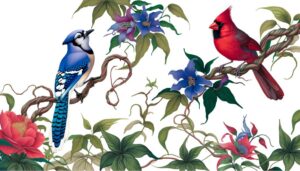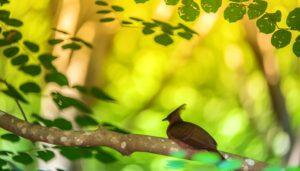5 Fascinating Facts About the Common Canary Cardinal Robin and Blue Jay
The Canary, renowned for its vibrant plumage and melodious song, originates from the Macaronesian Islands. Selective breeding has enhanced its diverse feather colors and complex vocalizations.
The Cardinal, with its vivid red plumage in males and more subdued hues in females, thrives in woodlands and shrublands across North and South America. The American Robin is easily identified by its orange breast and versatile song, migrating seasonally between breeding and wintering grounds.
The Blue Jay features bright blue, white, and black coloration, and is known for its intelligence and varied vocalizations, often inhabiting forests and suburban areas. Discover more fascinating details about these birds.

Key Takeaways
- Canaries are known for their vibrant plumage, melodious singing abilities, and adaptability to captivity.
- Cardinals exhibit striking red plumage in males, robust seed-crushing beaks, and are non-migratory with a stable population.
- Robins have a distinct orange breast, are migratory, and are indicators of ecological health due to their insect control and seed dispersal.
- Blue Jays are characterized by bright blue, white, and black coloration, expressive crests, and a versatile vocal range.
- Cardinals, Robins, and Blue Jays adapt well to diverse habitats including woodlands, gardens, and urban areas.
Canary Overview
The canary (Serinus canaria), a small passerine bird belonging to the finch family, is renowned for its vibrant plumage and melodious song, making it a popular subject of avian studies and a favored companion in domestic settings. Originating from the Macaronesian Islands, including the Canary Islands, these birds have been selectively bred for various traits, resulting in numerous color variations and song types.
Their adaptability to captivity and ease of breeding have made them a staple in aviculture. Canaries are often utilized in scientific research due to their complex vocalizations, which offer insights into neuroethological studies of learning and memory. This bird's historical role in coal mines as an early warning system for toxic gases underscores its significance beyond mere aesthetics.
Canary Characteristics
The canary is a species known for its vibrant feather colors. It exhibits a broad spectrum of hues from bright yellow to deep orange.
Its melodious singing abilities are a result of complex vocalization mechanisms. These mechanisms have been extensively studied for their intricate patterns and frequencies.
Additionally, canaries display distinct social behavior patterns. They often form cohesive flocks and demonstrate specific interactions within their groups.
Vibrant Feather Colors
Renowned for their striking plumage, canaries exhibit a wide array of vibrant feather colors that result from a combination of genetic factors and selective breeding. These hues range from the traditional bright yellow to shades of red, orange, and even white.
The pigmentary basis of these colors primarily involves carotenoids, which are absorbed from their diet and metabolized into various pigments. Selective breeding has accentuated these traits, enabling the development of specific color morphs.
The genetic foundation includes mutations affecting melanin and lipochrome distribution within the feathers, resulting in the diverse palette observed. This meticulous manipulation of genetics and diet underscores the canary's status as a symbol of beauty and diversity in the avian world, appealing to enthusiasts seeking aesthetic variety.
Melodious Singing Abilities
Possessing a highly developed syrinx, canaries are celebrated for their melodious singing abilities, which have been honed through both natural selection and meticulous breeding practices. The syrinx, located at the base of a bird's trachea, allows for intricate control over pitch and tone. Canaries exhibit a remarkable range of vocalizations, characterized by distinct syllables, trills, and warbles. These capabilities have made them a model organism for studying vocal learning and acoustic communication in birds.
| Feature | Description |
|---|---|
| Syrinx | Highly developed, enabling complex vocalizations |
| Vocal Range | Extensive, including trills and warbles |
| Breeding | Selective, enhancing specific song characteristics |
This combination of anatomical and genetic factors underlies the canary's unparalleled singing prowess, captivating avian enthusiasts and researchers alike.
Social Behavior Patterns
Canaries exhibit intricate social behavior patterns that are influenced by both environmental factors and genetic predispositions.
In their natural habitat, canaries display complex flocking behaviors, often forming small, cohesive groups that enhance their chances of survival. Social interactions are characterized by a hierarchy that dictates access to resources such as food and nesting sites.
These birds communicate through a series of vocalizations and body language, which serve functions ranging from establishing dominance to coordinating group activities.
Environmental variables, such as population density and availability of resources, greatly impact these behaviors. Genetic factors also play an essential role, as certain traits are heritable and can influence social structure and individual behavior within the flock.
Canary Habitat
The canary (Serinus canaria) thrives in a variety of habitats including forests, shrublands, and gardens, where it finds ample food sources and suitable nesting sites. Native to the Canary Islands, Madeira, and the Azores, this passerine bird adapts well to diverse environments due to its versatile diet of seeds, fruits, and insects.
Canaries prefer habitats with dense vegetation for shelter and protection from predators. In human-modified landscapes, they are often found in parks and residential areas where ornamental plants and feeders provide sustenance.
The adaptability of the canary to both wild and urban settings underscores its resilience and ability to exploit different ecological niches, ensuring its continued survival across various geographical regions.
Cardinal Overview
The cardinal, known for its vivid red plumage and distinct crest, is easily identifiable and displays pronounced sexual dimorphism.
This species mainly inhabits woodlands, gardens, and shrublands across North and Central America.
Its diet is diverse, consisting mainly of seeds, fruits, and insects, which it forages both on the ground and in vegetation.
Identification and Characteristics
Identifying the Northern Cardinal, Cardinalis cardinalis, involves noting its vibrant red plumage in males and the more subdued, yet equally distinctive, brownish tones in females, complemented by characteristic black masks and orange beaks.
The male's striking red coloration is a result of dietary carotenoids, signaling health and important, while the female's muted hues offer effective camouflage during nesting.
Both sexes possess a prominent crest on their heads, a robust, conical beak adapted for seed-crushing, and a melodious song repertoire.
Juveniles resemble females but exhibit a darker bill. Additionally, Cardinals have a body length of approximately 21-23 cm and a wingspan of 25-31 cm, making them a distinct presence in their environment.
Habitat and Range
Northern Cardinals, Cardinalis cardinalis, inhabit woodlands, gardens, shrublands, and wetlands across eastern and central North America, extending their range from southern Canada to northern Argentina. This species demonstrates remarkable adaptability, thriving in diverse habitats, including suburban areas where human activity is prevalent.
Cardinals are non-migratory, maintaining territories year-round, which they defend vigorously. Their presence in edge habitats, where different ecosystems meet, is particularly remarkable, as these areas provide abundant food sources and nesting sites.
Cardinals prefer dense, shrubby areas for nesting, often selecting locations close to the ground or within dense foliage. Their widespread distribution and habitat flexibility underscore their resilience and ability to exploit varied environmental conditions, contributing to their stable population across their expansive range.
Diet and Feeding
Feeding primarily on seeds and fruits, Northern Cardinals exhibit a diet that is both varied and seasonally adaptable. They have a particular affinity for sunflower seeds, safflower seeds, and various grains.
During the warmer months, their diet is supplemented with insects, such as beetles, grasshoppers, and caterpillars, which provide essential proteins for breeding and raising their young. The cardinal's stout, conical beak is well-adapted for cracking open hard seed coats, demonstrating their evolutionary specialization.
Additionally, they consume fruits like dogwood, wild grape, and mulberry, which are rich in vitamins and antioxidants. This dietary flexibility not only supports their nutritional needs but also allows them to thrive across diverse habitats, from woodlands to suburban gardens.
Cardinal Characteristics
The cardinal, known for its striking red plumage in males and subtle brownish tones in females, exhibits distinct sexual dimorphism that aids in visual identification and behavioral studies.
Males showcase a vivid red coloration, attributed to carotenoid pigments, which play an essential role in mate attraction and territorial defense.
Females, with their muted brownish hues accented by soft red highlights, provide effective camouflage during nesting.
Cardinals possess robust, conical bills ideal for seed-cracking, and their melodious songs, produced by a specialized syrinx, serve as both communication and territorial markers.
Their non-migratory nature allows for year-round observation, facilitating extensive research on their social behaviors and reproductive strategies. Notable is their adaptability, thriving in diverse environments.
Cardinal Habitat
The cardinal's habitat is characterized by its preference for densely vegetated areas such as woodlands, gardens, and shrublands, where it establishes its nesting locations.
Seasonal migration patterns reveal minimal long-distance movement, as cardinals generally remain within their established territories year-round.
Their diet primarily consists of seeds, fruits, and insects, which are abundant in these habitats, supporting their nutritional needs throughout various seasons.
Preferred Nesting Locations
In their natural habitat, cardinals primarily choose dense, shrubby areas for nesting, which provide ample cover and protection from predators. These birds exhibit a preference for locations that offer a combination of thick foliage and lower branch density, ensuring both concealment and accessibility.
Cardinals typically construct their nests between 3 to 10 feet above ground level, often within the forks of small tree branches or in dense shrubbery. The chosen sites are usually near open spaces, facilitating easy access for foraging. The nests are meticulously built using twigs, bark strips, leaves, and grasses, creating a sturdy yet camouflaged structure.
This selective nesting behavior is vital for maximizing reproductive success and reducing vulnerability to predation.
Seasonal Migration Patterns
Unlike many other bird species, Northern Cardinals demonstrate a largely sedentary lifestyle, exhibiting minimal seasonal migration patterns. These vibrant birds are typically found year-round within their established territories, primarily in the eastern and central regions of North America. Environmental factors such as temperature and food availability influence their movement within localized areas, but they do not undertake long-distance migrations.
Adapted to varied habitats, Northern Cardinals are found in woodlands, gardens, and shrublands. Their ability to thrive in both rural and urban settings underscores their ecological versatility.
This limited migratory behavior ensures that Northern Cardinals maintain a consistent presence in their habitats, contributing to stable population dynamics and offering a reliable subject for ornithological study.
Food and Diet
Northern Cardinals' ability to remain year-round in their habitats is closely linked to their diverse and adaptable diet, which includes seeds, fruits, and insects. This varied diet allows them to thrive across different seasons and environments.
During winter, they primarily consume seeds from grasses and trees, supplemented by berries. In spring and summer, their diet shifts to include a higher proportion of insects such as beetles, caterpillars, and grasshoppers, which provide essential protein for breeding and molting.
Additionally, they are known to eat a range of fruits and grains, ensuring they can exploit available food resources. This dietary flexibility is vital for their survival, enabling them to adapt to both seasonal changes and food scarcity effectively.
Robin Overview
The American Robin (Turdus migratorius), a member of the thrush family, is widely recognized for its distinct orange breast and melodious song, which heralds the arrival of spring in many regions of North America.
This bird species is known for its adaptability to diverse habitats, including urban areas, woodlands, and gardens. The American Robin is a migratory species, with populations traveling substantial distances between breeding and wintering grounds. Their presence in a region is often an indicator of ecological health.
Robust in population, the American Robin plays a pivotal role in controlling insect populations and dispersing seeds. Their nesting behavior and migratory patterns are subjects of extensive ornithological study, contributing significantly to our understanding of avian ecology.
Robin Characteristics
Exhibiting a striking orange breast and a melodious song, the American Robin (Turdus migratorius) is characterized by its robust physique, keen foraging skills, and distinctive migratory behaviors. This medium-sized passerine bird demonstrates notable adaptability and resilience across diverse environments.
Key characteristics include:
- Plumage: A grey-brown back contrasting with a warm orange-red breast.
- Diet: Omnivorous, with a preference for earthworms, insects, and fruit.
- Vocalization: A complex series of melodious whistles, often used in territorial defense.
- Behavior: Highly social, forming large flocks during migration and winter.
These traits not only define the American Robin's ecological role but also contribute to its widespread recognition and admiration among bird enthusiasts.
Robin Habitat
How does the American Robin's habitat range from urban parks to remote woodlands, demonstrating its remarkable ecological versatility and adaptability?
The American Robin (Turdus migratorius) thrives in diverse environments, from manicured lawns to dense forests. This species exhibits a preference for areas with abundant food sources, such as earthworms, insects, and fruit.
Robins often inhabit deciduous forests, suburban gardens, and agricultural fields, seamlessly shifting between human-altered and natural landscapes. Their nests, constructed from grasses and mud, are frequently found in trees, shrubs, and even building ledges.
The robin's adaptability to varying climates and conditions, including temperate and subarctic regions, underscores its success in colonizing a wide range of habitats. This flexibility ensures their continued prevalence across North America.
Blue Jay Overview
While the American Robin showcases ecological versatility, the Blue Jay (Cyanocitta cristata) exemplifies a remarkable combination of intelligence and adaptability within its diverse habitats. Native to North America, Blue Jays are commonly found in deciduous and mixed forests, as well as urban and suburban areas. Their diet is omnivorous, comprising seeds, nuts, fruits, and small invertebrates.
Key attributes of Blue Jays:
- Cognitive Abilities: Known for problem-solving skills and complex social behaviors.
- Communication: Utilize a wide range of vocalizations and mimicry, including imitating hawk calls.
- Migration Patterns: Partial migrants; some populations migrate while others remain year-round residents.
- Nesting Habits: Construct cup-shaped nests in tree branches, often using twigs, grass, and mud.
These attributes underscore the Blue Jay's ecological significance and resilience.
Blue Jay Characteristics
The Blue Jay (Cyanocitta cristata) possesses distinctive physical characteristics, such as vibrant blue plumage, a pronounced crest, and a striking black necklace-like collar. These features, combined with their white underparts and black-bordered wings, make Blue Jays highly recognizable.
Key Characteristics | Description
——————- | ———–
Coloration | Bright blue, white, and black
Crest | Prominent and expressive
Size | Approximately 25-30 cm in length
Diet | Omnivorous; includes nuts, seeds, and insects
Blue Jays are known for their intelligence and complex social behaviors. Their calls vary from harsh jeers to melodic whistles, showcasing their vocal versatility. Often seen in forests, parks, and suburban areas, Blue Jays play an essential role in seed dispersion, thereby contributing to forest regeneration.
Conclusion
In the mosaic of avian life, the canary, cardinal, robin, and blue jay each represent unique threads woven into the intricate tapestry of nature. Their distinct characteristics and habitats symbolize the diverse yet interconnected roles within ecosystems.
The canary's vibrant song, the cardinal's striking plumage, the robin's heralding of spring, and the blue jay's intelligence collectively underscore the delicate balance and beauty of avian biodiversity. Each species, a unique note in nature's symphony, exemplifies evolutionary marvels.






